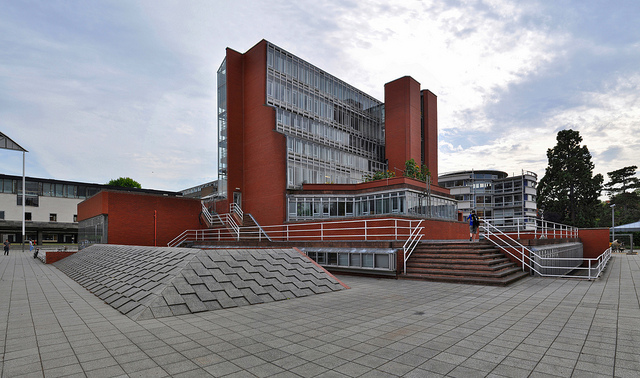How is Deadpool like a business park in Slough? They’re both postmodern. If you just wanted to find out the answer to the click-bait headline, there it is. If you want to find out more then read on.
For a better answer to the question we need to ask: what is postmodernism? Well, it’s like pornography, in that it’s only acceptable to look at it in public as part of an art installation or at the sort of parties that I don’t get invited to. Also, like pornography, it’s difficult to define, but you know it when you see it.
You can find postmodernism in contemporary art galleries, usually in the room that just has a load of tyres piled up in the corner. You can find it on the reading lists for MAs in contemporary literature. You can find in in the architecture of post-industrial areas that were rebuilt in the 1990s, the places where the decaying factories and wharves were replaced with Italian restaurants and coffee shops that aspired to be just like Central Perk.
Postmodernism might be a movement in high brow, high class, high cost, impenetrable, elitist and confusing art forms, but it doesn’t have to be an exclusive idea. You can see postmodernism in the cinema and you don’t have to go to the ICA or even your local Picturehouse to see it.
There’s lots of postmodernism in Deadpool and Deadpool 2. Looking at what makes these films different from every other superhero film will help us answer the question of what postmodernism is.
One characteristic of postmodernism is irony. There’s irony in the way that Deadpool contradicts and mocks the expected plot of a superhero film. The second Deadpool film opens with (spoilers at the end of this sentence) Deadpool committing suicide by blowing himself up on top of a pyre of petrol cans. Very much the opposite of what you expect from a superhero film.
Irony relies on the audience understanding the context of the story, which Deadpool shows when he openly mocks the tropes of the superhero film that we know well, such as the “superhero landing” that hurts his knees.
Self-referencing is a feature of postmodernism. According to Wikipedia, which is always right, “self-reference occurs in literature and film when an author refers to his or her own work in the context of the work itself.” Adaptation is the epitome of this, as it’s a film about writing the script you are watching. Deadpool is filled with self-references, such as in Deadpool 2 when Deadpool mentions how much the first film grossed relative to The Passion of the Christ.
This works because Deadpool is aware that he is a character in his own film, which is itself another characteristic of postmodernism. For example, in Tom Stoppard’s play Rosencrantz and Guildenstern Are Dead, Rosencrantz and Guildenstern are aware that they are minor characters in Hamlet’s story. Deadpool is the bizarre cross between Rosencrantz and Guildenstern and Bugs Bunny, but the ongoing commentary on the work of fiction as it progresses – together with meta-references, such as mentioning Patrick Stewart – make Deadpool quintessentially postmodern.
Scepticism about the world, objective ideas of truth and the grand narratives and theories that characterised the modernist era, also define postmodernism. Deadpool is not awash with moral relativism, although he is very relaxed about killing people, but he is certainly sceptical about the future of his own franchise, hence the need to recruit young talent for his X-Force.
What makes Deadpool different from every other superhero is the films’ entire tone of irreverence. Deadpool is also pushing back against the big ideas of superhero films, you could say Deadpool is sceptical about what a superhero film stands for and wants to stand for something else.
This is the heart of postmodernism, it is more than a criticism of the modernist movement that came before it. It is a rebellion against modernist values and aesthetics. Making art that is sceptical, self-referencing and ironic is an act of rebellion against the grand narratives of modernism. Writing books that question the objective truths of modernism is an act of rebellion. Adding decorative arches to the facade of a building, such as the McKay trading estate in Blackthorne Road, Slough, is an act of rebellion against plain, rectilinear modernism.
Deadpool can also be seen as a rebellion against the established superhero films. From making fun of DC’s overly dark tone or mocking the lack of X-Men cameos in Deadpool 2 (a joke aimed at all superhero films’ need to cross over characters to be constantly promoting other films), Deadpool is pushing back against the forces that have come to dominate superhero films, just as James Frazer Stirling did with his for deisgn for Cambridge University History Faculty Building, pictured above. Deadpool does things differently and doesn’t care about critiques from the establishment. This is completely postmodern.
Deadpool is bringing postmodernism out of the art gallery and posh book clubs into the cinema where we can all enjoy it. I loved the self-awareness, self-referencing and rude jokes of the first film and I had high hopes for the sequel. Find out what I, and my podcast co-host Nick, thought of Deadpool 2 below:
The image of the the Cambridge University History Faculty Building used above was created by seier+seier and they retain the copyright. It is used under creative commons.


